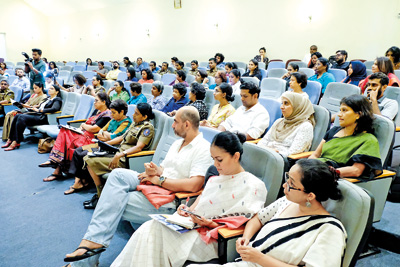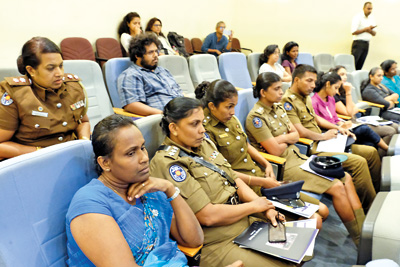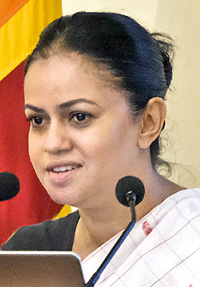Arts
A cybercrime victim needs to know she can seek justice
Nilakshi*, a 16-year-old girl, was in a relationship with a boy. As part of the growing trend for young couples, she had sent him semi-nude photos of herself. Two years into the relationship, Nilakshi realised he was not suitable for her, and she would rather focus on her studies.
A while later, Nilakshi’s brother received a message from an anonymous number informing him that his sister’s nude photos were circulating on social media and other websites. He was then sent these pictures. Nilakshi’s brother beat her for the shame and embarrassment she had caused her family, and the situation sent Nilakshi into severe depression. She felt that her only options were to either start communicating with her ex to stop the circulation of the pictures, or to commit suicide.
Several counselling sessions later, and with the assistance of Women in Need (WIN) and the police, the matter was settled with a strict warning to the perpetrator. However, the possibility of these images resurfacing remains high. It will remain an endless concern and psychological burden she will carry all her life.
Cases like Nilakshi’s – the fallout of a relationship – make up 70% of the cases that the Criminal Investigation Department (CID) deals with on a daily basis.
Violence against women has reached a dangerous new precedent with the rise of cyber stalking and cyber harrassment. A staggering majority of women and girls, from as young as eleven years old, are being targeted, defamed, and abused online. The horrifying trend of pressuring people into taking explicit photographs and then blackmailing them with threats of exposure has stalked the lives of countless victims, some to the point of no return. The prevalence of this issue in Sri Lanka has hit a breaking point, where gender based violence (GBV) has become deeply rooted in today’s society based on unequal power relations, stigma and shame.
After receiving an increasing number of complaints about the harassment of women and girls on online platforms, Women In Need began looking into ways to address this issue with tangible results. On February 28, WIN together with CID launched the Standard Operating Procedure (SOP) for the Police in Addressing Complaints on Cyber Harassment. WIN also shared key findings on their research on the Technology Facilitated Violence against Women and Girls in Sri Lanka, together with consultants and experts in the field.

Timely steps: Police officials, lawyers, WIN members and other concerned people at the launch (above and top). Pix by Amila Gamage
Since their inception in 1987, WIN has worked towards addressing the issues of violence against women and girls in Sri Lanka, while providing free crisis intervention services to vulnerable victims of violence and advocating for the much needed reform systems and frameworks.
As their research showed, some of the biggest challenges in addressing cyber harassment included low awareness that a crime may have been committed, the lack of policy or procedure, gaps in law training, political will and the lack of resources. Speakers at the launch Ermiza Tegal and Deanna Uyangoda, Attorneys-at-Law explained that there is a knowledge gap with regards to the crimes involved.
Aside from this, the approach and procedure adopted by the Police are varied, with a strong tendency to either not entertain or pass on the complaint to CID Cyber Crimes. There are also serious challenges to handling sensitive material and securing privacy of the victims.
Online or digital abuse is an umbrella term referring to a range of harmful behaviour experienced on various online platforms as well as mobile phones and other electronic devices.
According to WIN, this has also become one of the most easiest and most offensive form of harrasment against a person, and is the newest manifestation of sexual violence against women and girls.
As the Chairman of WIN Savithri Wijesekera points out, the unauthorised distribution of a person’s sexual images, violates, humiliates and intimidates the victim and the damage done is irreversible and irreparable. The psychological impact of this is also considered longer lasting as opposed to other forms of violence, since these images keep circulating online.
“The problem is not actual impunity, rather it’s the perception of impunity. He thinks he can get away with it. He knows he can get away with it and that is why he keeps doing it,” Deanne shares, adding that the aim is to curtail this issue. There is also a need for more resources for the police to tackle these issues, because taking a complaint is simply the beginning.
Eliminating the fear faced by most victims placing the complaint is of utmost importance, and in order to do this the victim needs to be put first. The much-needed implementation of the SOP will mean that anyone, in any part of the country, will be able to seek assistance from the police with the hope of finally getting justice for this insidious crime.

Hans Billimoria

Deanna Uyangoda
Box: Punishment alone won’t do; prevention and education vital
Addressing these issues in the long term cannot be limited by a strict approach, explains Hans Billimoria from the Grassrooted Trust. Simply making sure the perpetrators are punished is only one part of the solution. Most importantly, preventive education in schools and educating the parents on these issues need to be carried out as well.
As Hans points out, today children as young as 11 to 13 years old are getting online, as the vast majority of people now use the Internet to maintain relationships above anything else. In the same vein, this level of connectivity comes a dark side.
“Love and trust are some of the main motivations for sending nude pictures between young people. The ‘nude’ is now a symbol of fidelity,” he explains.
Though such content may have been consensual at the time, breakdowns in relationships result in the unlawful distribution of these images to third parties — a direct violation. Hans recalls handling four cases where the girls have preferred the sexual violence, to their parents finding out that they’ve sent these pictures.
“What is the status of relationship between the parent and the child that allows for this blackmail and control?”
Prevention starts with education, and Hans notes that people need to be educated on data retrieval software. Personal data on phones and laptops are easily retrievable through software, at any given phone repair shop. “So you’d think the pictures are gone once they are deleted. But they aren’t.”
Another growing problem is the platforms on which these images could be shared. According to the experimental research work on the local cybersphere, it was revealed that the girl most often would share an image with the boy (after much convincing or emotional blackmail) and the boy then shares this on his Whatsapp groups and larger Dropbox folders.
Hans explains that online violations are not just about nude pictures, it also has much to do with our general attitude. There is a lot to learn, starting from a young age. “Respect, consent, empathy, focusing on self esteem and helping our children understand what trust means, and that they need to be sensible and think through the consequences of their actions.”
| What is SOP? | |
| Standard Operating Procedure (SOP) for the Police in Addressing Complaints on Cyber Harassment: Recording of complaint to be improved in order to improve investigation and prosecution All complaints will be recorded Identification of offence to be improved Separate counts of offences to be recorded Sensitive material will be stored in a manner ensuring privacy and integrity of evidence Technical assistance will be obtained (Police IT division, CID) Court orders will be obtained to get further evidence in a timely manner Complaints will be notified to DIG Crimes, Director of Women and Children’s Bureau for monitoring Improved victim focus and security to improve confidence in policing institution Complaint will be recorded in the first instance The nature of the victimhood will be taken into consideration (requires safe space, may need accompaniment) Complainants ensured of level of privacy of sensitive material Victim blaming/shaming will be eliminated Re-victimization caused by repetition of complaint to be reduced Complaints to be processed without delay Focus on engaging remedies: taking down harmful content, protection orders, victim and witness protections Existing legal framework to be effectively used Sexual harassment (Section 345 Penal code) Criminal Intimidation (Section 483 Penal code) Cheating by personation (Section 399 Penal Code) Make, produce or have possession of obscene material (Obscene publications) Importing, exporting, conveying or circulation (Obscene publications) Accesses victim’s computer/information within computer (Computer Crimes Act) Information obtained (Downloads, uploads, copies) without lawful authority from another’s computer (Computer Crimes Act) Domestic violence (Prevention of Domestic Violence Act)
|
| Punishment alone won’t do; prevention and education vital | |
| Addressing these issues in the long term cannot be limited by a strict approach, explains Hans Billimoria from the Grassrooted Trust. Simply making sure the perpetrators are punished is only one part of the solution. Most importantly, preventive education in schools and educating the parents on these issues need to be carried out as well. As Hans points out, today children as young as 11 to 13 years old are getting online, as the vast majority of people now use the Internet to maintain relationships above anything else. In the same vein, with this level of connectivity comes a dark side. “Love and trust are some of the main motivations for sending nude pictures between young people. The ‘nude’ is now a symbol of fidelity,” he explains. Though such content may have been consensual at the time, breakdowns in relationships result in the unlawful distribution of these images to third parties — a direct violation. Hans recalls handling four cases where the girls have preferred the sexual violence, to their parents finding out that they’ve sent these pictures. “What is the status of relationship between the parent and the child that allows for this blackmail and control?” Prevention starts with education, and Hans notes that people need to be educated on data retrieval software. Personal data on phones and laptops are easily retrievable through software, at any given phone repair shop. “So you’d think the pictures are gone once they are deleted. But they aren’t.” Another growing problem is the platforms on which these images could be shared. According to the experimental research work on the local cybersphere, it was revealed that the girl most often would share an image with the boy (after much convincing or emotional blackmail) and the boy then shares this on his Whatsapp groups and larger Dropbox folders. Hans explains that online violations are not just about nude pictures, it also has much to do with our general attitude. There is a lot to learn, starting from a young age. “Respect, consent, empathy, focusing on self esteem and helping our children understand what trust means, and that they need to be sensible and think through the consequences of their actions.”
|

